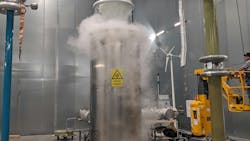If my inbox is any indication, this year is going to an exciting one! New grid technologies are being introduced at an incredible rate. Older applications seem to be evolving just as fast. It’s providing efficient methods for modernizing the power grid without massive investments. There are so many fascinating topics it’s hard selecting one for this month. That’s what makes it so interesting.
One release came out focused on an estimated 260 gigawatts of distributed energy resources being added to grid by 2028. Another reported that the power grid needs 160 gigawatts of virtual power plants by 2030. Hmm, this is getting interesting. Glad I ran into this because it has the makings of an interesting longer article.
Someone sent me a study discussing datacenters and their appetite for electricity. In 2023 they had consumed 4.4% of the total electricity generated in the US, and that could more than double by 2028. A curious press release came from a new Chinese AI company, DeepSeek. They have the solution for datacenter power consumption with a more energy-efficient AI product. It purportedly uses ten to forty times less power than their competition.
Technical Adventure
When I opened an email from the SuperGrid Institute (France), I had my subject. They had seen several of my articles on HVDC (high-voltage direct current) networks and wanted to talk about their HVDC work. They had developed a distinctive HVDC power circuit breaker. HVDC circuit breakers are one of my favorite subjects since 2012, so I contacted them.
November 2012 stands out in my mind because that was the year I was invited to tour ABB’s (now Hitachi Energy) HVDC research facilities in Switzerland and Sweden. That was like a week at Disneyland, but behind the curtain. It was a whirlwind trip, talking with their experts along with seeing their labs and factories. And you guessed it, they included their brand-new prototype HVDC circuit breaker. It was a hybrid (i.e. solid-state device and mechanical) design they were testing.
What makes the HVDC circuit breaker so fascinating is the physics behind the device. AC breakers take advantage of the current zero point in the AC waveform to interrupt the current, but there is no zero current point in the DC waveform. That results in a DC circuit breaker that needs help, which is where it gets complicated. There are several methods to do this, but it’s a complex specialty. If you’re interested, you can find detailed discussions on Hitachi Energy’s and Siemens Energy’s websites.
Super Cool Tech
Let’s get back to the SuperGrid Institute. Their HVDC circuit breaker is a unique approach. It’s a DC mechanical breaker combined with a resistive superconducting fault current limiter (RSFCL), a vacuum chamber, and current injection. The RSFCL design is based “on a series of ten “pancake coils” of superconducting tape in a cryostat where the liquid nitrogen has been brought down to 68 degrees Kelvin (-205º C).”
SuperGrid Institute said they are taking advantage of a characteristic of superconductors. Basically the superconductor acts as a high resistance to fault limiting the current and a low resistance to normal currents passing the power. The RSFCL is modular and stackable for higher nominal voltage and current levels. Last December, the Institute successfully tested their HVDC circuit breaker up to 50 kV. The SuperGrid Institute’s cryogenic HVDC breaker is a welcome addition.
These HVDC circuit breakers are a critical element in constructing a multi-terminal HVDC power grid. In 2020 the Chinese utility State Grid energized the world’s first meshed HVDC grid with four nodes and 16 propriety HVDC breakers. Europe is in the planning stages for a meshed HVDC grid with an operational target date of 2032. In the U.S., however, some experts say a meshed HVDC grid it’s still science fiction.
There are several suppliers developing HVDC circuit breaker technology. Hitachi Energy has its hybrid HVDC circuit breaker that’s available for deployment at voltages up to 1100 kV. Also, Siemens Energy and Mitsubishi Electric announced a partnership to develop an HVDC circuit breaker last year. GE Vernova and Dutch-German grid operator TenneT are working together to develop a 525 kV HVDC circuit breaker according to an announcement last year.
The global HVDC transmission market hit USD 11.4 billion in 2023. It’s expected to grow annually about 5.4% over the next three years and the HVDC circuit breaker is an important part of that growth. This a trending topic that deserves careful watching!
About the Author
Gene Wolf
Technical Editor
Gene Wolf has been designing and building substations and other high technology facilities for over 32 years. He received his BSEE from Wichita State University. He received his MSEE from New Mexico State University. He is a registered professional engineer in the states of California and New Mexico. He started his career as a substation engineer for Kansas Gas and Electric, retired as the Principal Engineer of Stations for Public Service Company of New Mexico recently, and founded Lone Wolf Engineering, LLC an engineering consulting company.
Gene is widely recognized as a technical leader in the electric power industry. Gene is a fellow of the IEEE. He is the former Chairman of the IEEE PES T&D Committee. He has held the position of the Chairman of the HVDC & FACTS Subcommittee and membership in many T&D working groups. Gene is also active in renewable energy. He sponsored the formation of the “Integration of Renewable Energy into the Transmission & Distribution Grids” subcommittee and the “Intelligent Grid Transmission and Distribution” subcommittee within the Transmission and Distribution committee.
